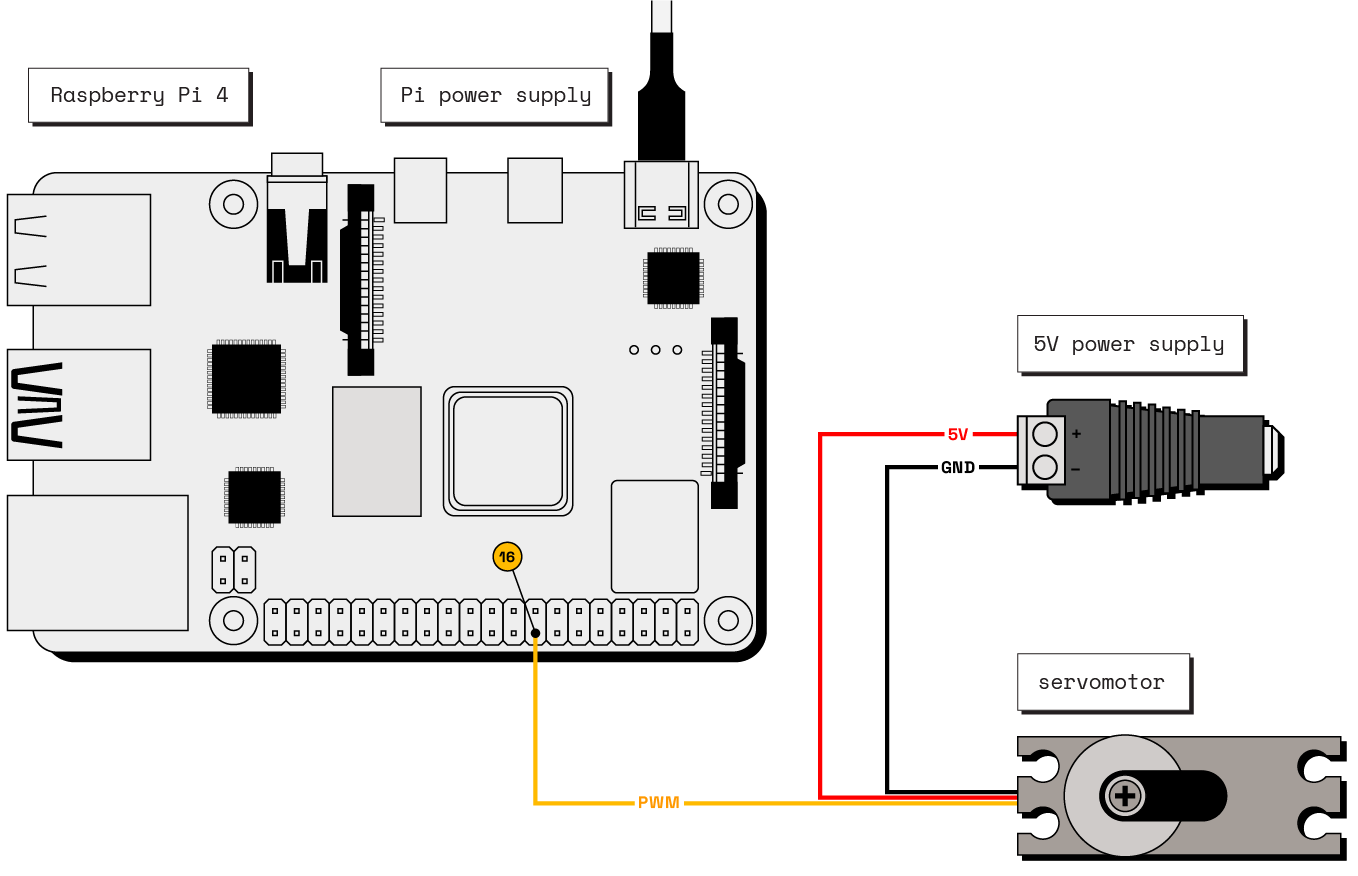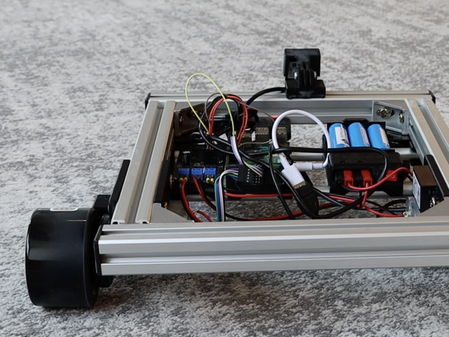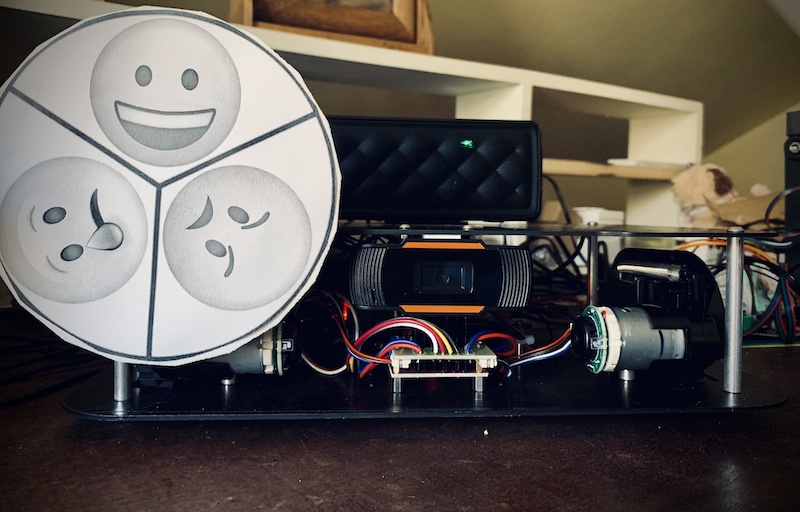Servo Component
The servo component supports “RC” or “hobby” servo motors. These are small motors with built-in potentiometer position sensors, enabling you to control the angular position of the servo precisely.
As servos can use a lot of power, drawing voltage away from a board, you should power your servo with its own power supply in most cases.
The following shows an example wiring diagram for a hobby servo wired to a pi board:

The colors of the servo wires in this diagram may not match your servo. Refer to your servo’s data sheet for wiring specifications.
Most machines with a servo need at least the following hardware:
- A board component that can run
viam-server - A servo
- A power supply for the board
- A power supply for the servo
Related services
Tip
The Viam servo component supports hobby servos.
If your motor is coupled with an encoder, not a potentiometer, for position feedback, you should not configure it as a servo. Check your device’s data sheet and configure that type of servo as an encoded motor.
Available models
To use your servo component, check whether one of the following models supports it.
For configuration information, click on the model name:
Add support for other models
If none of the existing models fit your use case, you can create a modular resource to add support for it.
| Model | Description |
|---|---|
gpio | A hobby servo. |
Add support for other models
If none of the existing models fit your use case, you can create a modular resource to add support for it.
viam-micro-server works differently from the RDK, so creating modular resources for it is different.
Refer to the Micro-RDK Module Template on GitHub for information on how to create custom resources for your viam-micro-server machine.
You will need to recompile and flash your ESP32 yourself instead of using Viam’s prebuilt binary and installer.
Control your servo with Viam’s client SDK libraries
To get started using Viam’s SDKs to connect to and control your machine, go to your machine’s page on the Viam app, navigate to the CONNECT tab’s Code sample page, select your preferred programming language, and copy the sample code.
API key and API key ID
By default, the sample code does not include your machine API key and API key ID. We strongly recommend that you add your API key and API key ID as an environment variable and import this variable into your development environment as needed.
To show your machine’s API key and API key ID in the sample code, toggle Include API key on the CONNECT tab’s Code sample page.
Caution
Do not share your API key or machine address publicly. Sharing this information could compromise your system security by allowing unauthorized access to your machine, or to the computer running your machine.
When executed, this sample code will create a connection to your machine as a client. Then control your machine programmatically by adding API method calls as shown in the following examples.
These examples assume you have a servo called "my_servo" configured as a component of your machine.
If your servo has a different name, change the name in the code.
Be sure to import the servo package for the SDK you are using:
from viam.components.servo import Servo
import (
"go.viam.com/rdk/components/servo"
)
API
The servo component supports the following methods:
| Method Name | Description | viam-micro-server Support |
|---|---|---|
Move | Move the servo to the desired angle in degrees. | |
GetPosition | Get the current set angle of the servo in degrees. | |
GetGeometries | Get all the geometries associated with the servo in its current configuration, in the frame of the servo. | |
IsMoving | Returns whether the servo is actively moving (or attempting to move) under its own power. | |
Stop | Stop the servo from moving. | |
Reconfigure | Reconfigure this resource. | |
DoCommand | Execute model-specific commands that are not otherwise defined by the component API. | |
FromRobot | Get the resource from the provided robot with the given name. | |
GetResourceName | Get the ResourceName for this servo with the given name. | |
Close | Safely shut down the resource and prevent further use. |
Move
Move the servo to the desired angle in degrees.
Stability Notice
Support for continuous servos with the GPIO servo model is experimental. Stability is not guaranteed. Breaking changes are likely to occur, and occur often.
If you are using a continuous rotation servo, you can use the Move command, but instead of moving to a given position, the servo will start moving at a set speed.
The speed will be related to the “angle” you pass in as a linear approximation. 90 degrees represents stop, 91 to 180 represents counter-clockwise rotation from slowest to fastest, and 89 to 1 represents clockwise from slowest to fastest. It is recommended that you test your servo to determine the desired speed.
viam-micro-server.Parameters:
angle(int) (required): The desired angle of the servo in degrees.extra(Mapping[str, Any]) (optional): Extra options to pass to the underlying RPC call.timeout(float) (optional): An option to set how long to wait (in seconds) before calling a time-out and closing the underlying RPC call.
Returns:
- None.
Example:
my_servo = Servo.from_robot(robot=robot, name="my_servo")
# Move the servo from its origin to the desired angle of 10 degrees.
await my_servo.move(10)
# Move the servo from its origin to the desired angle of 90 degrees.
await my_servo.move(90)
For more information, see the Python SDK Docs.
Parameters:
ctx(Context): A Context carries a deadline, a cancellation signal, and other values across API boundaries.angleDeg(uint32): The desired angle of the servo in degrees.extra(map[string]interface{}): Extra options to pass to the underlying RPC call.
Returns:
- (error): An error, if one occurred.
Example:
// Move the servo from its origin to the desired angle of 30 degrees.
myServoComponent.Move(context.Background(), 30, nil)
For more information, see the Go SDK Docs.
GetPosition
Get the current set angle of the servo in degrees.
Supported by viam-micro-server.
Parameters:
extra(Mapping[str, Any]) (optional): Extra options to pass to the underlying RPC call.timeout(float) (optional): An option to set how long to wait (in seconds) before calling a time-out and closing the underlying RPC call.
Returns:
- (int): The current angle of the servo in degrees.
Example:
my_servo = Servo.from_robot(robot=robot, name="my_servo")
# Move the servo from its origin to the desired angle of 10 degrees.
await my_servo.move(10)
# Get the current set angle of the servo.
pos1 = await my_servo.get_position()
# Move the servo from its origin to the desired angle of 20 degrees.
await my_servo.move(20)
# Get the current set angle of the servo.
pos2 = await my_servo.get_position()
For more information, see the Python SDK Docs.
Parameters:
ctx(Context): A Context carries a deadline, a cancellation signal, and other values across API boundaries.extra(map[string]interface{}): Extra options to pass to the underlying RPC call.
Returns:
Example:
// Get the current set angle of the servo.
pos1, err := myServoComponent.Position(context.Background(), nil)
// Move the servo from its origin to the desired angle of 20 degrees.
myServoComponent.Move(context.Background(), 20, nil)
// Get the current set angle of the servo.
pos2, err := myServoComponent.Position(context.Background(), nil)
logger.Info("Position 1: ", pos1)
logger.Info("Position 2: ", pos2)
For more information, see the Go SDK Docs.
Parameters:
Returns:
Example:
var angle = await myServo.position();
For more information, see the Flutter SDK Docs.
GetGeometries
Get all the geometries associated with the servo in its current configuration, in the frame of the servo. The motion and navigation services use the relative position of inherent geometries to configured geometries representing obstacles for collision detection and obstacle avoidance while motion planning.
Parameters:
extra(Mapping[str, Any]) (optional): Extra options to pass to the underlying RPC call.timeout(float) (optional): An option to set how long to wait (in seconds) before calling a time-out and closing the underlying RPC call.
Returns:
- (List[viam.proto.common.Geometry]): The geometries associated with the Component.
Example:
geometries = await component.get_geometries()
if geometries:
# Get the center of the first geometry
print(f"Pose of the first geometry's centerpoint: {geometries[0].center}")
For more information, see the Python SDK Docs.
IsMoving
Returns whether the servo is actively moving (or attempting to move) under its own power.
Parameters:
timeout(float) (optional): An option to set how long to wait (in seconds) before calling a time-out and closing the underlying RPC call.
Returns:
- (bool): Whether the servo is moving.
Example:
my_servo = Servo.from_robot(robot=robot, name="my_servo")
print(my_servo.is_moving())
For more information, see the Python SDK Docs.
Parameters:
ctx(Context): A Context carries a deadline, a cancellation signal, and other values across API boundaries.
Returns:
Example:
// This example shows using IsMoving with an arm component.
myArm, err := arm.FromRobot(machine, "my_arm")
// Stop all motion of the arm. It is assumed that the arm stops immediately.
myArm.Stop(context.Background(), nil)
// Log if the arm is currently moving.
is_moving, err := myArm.IsMoving(context.Background())
logger.Info(is_moving)
For more information, see the Go SDK Docs.
Parameters:
- None.
Returns:
Example:
var isItMoving = await myServo.isMoving();
For more information, see the Flutter SDK Docs.
Stop
Stop the servo from moving.
Supported by viam-micro-server.
Parameters:
extra(Mapping[str, Any]) (optional): Extra options to pass to the underlying RPC call.timeout(float) (optional): An option to set how long to wait (in seconds) before calling a time-out and closing the underlying RPC call.
Returns:
- None.
Example:
my_servo = Servo.from_robot(robot=robot, name="my_servo")
# Move the servo from its origin to the desired angle of 10 degrees.
await my_servo.move(10)
# Stop the servo. It is assumed that the servo stops moving immediately.
await my_servo.stop()
For more information, see the Python SDK Docs.
Parameters:
ctx(Context): A Context carries a deadline, a cancellation signal, and other values across API boundaries.extra(map[string]interface{}): Extra options to pass to the underlying RPC call.
Returns:
- (error): An error, if one occurred.
Example:
// This example shows using Stop with an arm component.
myArm, err := arm.FromRobot(machine, "my_arm")
// Stop all motion of the arm. It is assumed that the arm stops immediately.
err = myArm.Stop(context.Background(), nil)
For more information, see the Go SDK Docs.
Parameters:
Returns:
- Future<void>
Example:
await myServo.stop();
For more information, see the Flutter SDK Docs.
Reconfigure
Reconfigure this resource. Reconfigure must reconfigure the resource atomically and in place.
Parameters:
ctx(Context): A Context carries a deadline, a cancellation signal, and other values across API boundaries.deps(Dependencies): The resource dependencies.conf(Config): The resource configuration.
Returns:
- (error): An error, if one occurred.
For more information, see the Go SDK Docs.
DoCommand
Execute model-specific commands that are not otherwise defined by the component API.
For built-in models, model-specific commands are covered with each model’s documentation.
If you are implementing your own servo and add features that have no built-in API method, you can access them with DoCommand.
Supported by viam-micro-server.
Parameters:
command(Mapping[str, ValueTypes]) (required): The command to execute.timeout(float) (optional): An option to set how long to wait (in seconds) before calling a time-out and closing the underlying RPC call.
Returns:
- (Mapping[str, viam.utils.ValueTypes]): Result of the executed command.
Raises:
- (NotImplementedError): Raised if the Resource does not support arbitrary commands.
Example:
command = {"cmd": "test", "data1": 500}
result = component.do(command)
For more information, see the Python SDK Docs.
Parameters:
ctx(Context): A Context carries a deadline, a cancellation signal, and other values across API boundaries.cmd(map[string]interface{}): The command to execute.
Returns:
- (map[string]interface{}): The command response.
- (error): An error, if one occurred.
Example:
// This example shows using DoCommand with an arm component.
myArm, err := arm.FromRobot(machine, "my_arm")
command := map[string]interface{}{"cmd": "test", "data1": 500}
result, err := myArm.DoCommand(context.Background(), command)
For more information, see the Go SDK Docs.
FromRobot
Get the resource from the provided robot with the given name.
Parameters:
robotRobotClient (required)nameString (required)
Returns:
For more information, see the Flutter SDK Docs.
GetResourceName
Get the ResourceName for this servo with the given name.
Parameters:
name(str) (required): The name of the Resource.
Returns:
- (viam.proto.common.ResourceName): The ResourceName of this Resource.
Example:
# Can be used with any resource, using an arm as an example
my_arm_name = my_arm.get_resource_name("my_arm")
For more information, see the Python SDK Docs.
Parameters:
nameString (required)
Returns:
Example:
// Example:
var name = Servo.getResourceName('myServo');
For more information, see the Flutter SDK Docs.
Close
Safely shut down the resource and prevent further use.
Parameters:
- None.
Returns:
- None.
Example:
await component.close()
For more information, see the Python SDK Docs.
Parameters:
ctx(Context): A Context carries a deadline, a cancellation signal, and other values across API boundaries.
Returns:
- (error): An error, if one occurred.
Example:
// This example shows using Close with an arm component.
myArm, err := arm.FromRobot(machine, "my_arm")
err = myArm.Close(ctx)
For more information, see the Go SDK Docs.
Troubleshooting
You can find additional assistance in the Troubleshooting section.
You can also ask questions in the Community Discord and we will be happy to help.
Next steps
Was this page helpful?
Glad to hear it! If you have any other feedback please let us know:
We're sorry about that. To help us improve, please tell us what we can do better:
Thank you!

